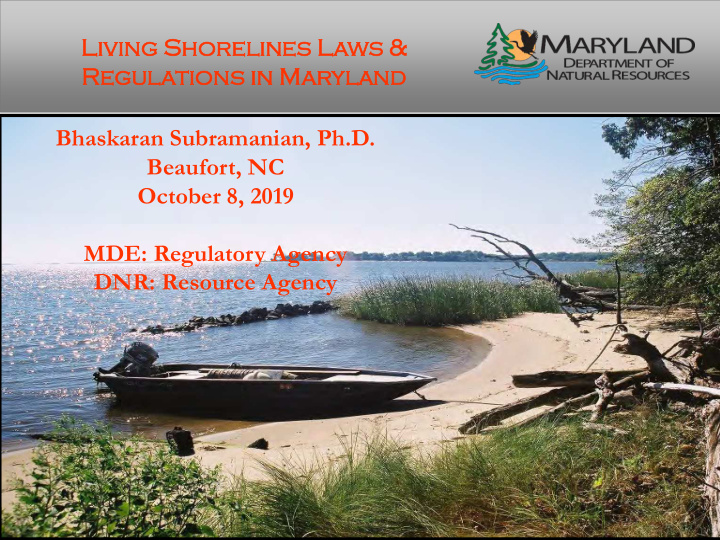



Livin ing g Shoreline ines s Laws s & Regulation ations s in Maryland and Bhaskaran Subramanian, Ph.D. Beaufort, NC Image or Graphic October 8, 2019 MDE: Regulatory Agency DNR: Resource Agency 1
Key Points… • History of how MD regulates • MD’s permit process: individual and general permits- state and federal • % of LS vs structural • State’s strategies to increase LS • Demonstration projects: moving science forward • Emerging regulatory challenges
How does MD Permit… • MDSPGP: first established in 1996 (valid for 5 years) • Currently MDSPGP 5. • Category A: General Permit – Less than 500 LF shoreline; and / or – 35LF maximum channelward encroachment • Category B: Individual Permit • Independent review by Corps and other state / local and other federal agencies (such as NOAA Fisheries).
Shore Erosion Control Law: 1968 -The Shore Erosion Control Program was established in 1968 by act of the Maryland's General Assembly. -The Shore Erosion Control Program provides both technical and financial assistance to landowners in completing both structural and living shoreline projects. -Vegetative stabilization- preferred , but structural projects are used in areas with high rates of erosion. Vegetative Stabilization- erstwhile -Technical assistance is provided through Living Shorelines site evaluations, problem assessments and recommended solutions.
Erosion Control Measures: Order of preference • No action • Nonstructural shoreline stabilization • Structural measures to stabilize nonstructural stabilization • Revetments • Breakwaters • Groins • Bulkheads • COMAR 26.24.04.01
Living Shorelines Protection Act of 2008 -Bill passed into Law October 2008; regulations implemented in February 2013. -The law provides the regulatory agency with a strong foundation to promote alternate shoreline erosion control measures. - The Law clearly states: “Improvements to protect a person’s property against erosion shall consist of non - structural shoreline stabilization measures (i.e. living shorelines) except where the person can demonstrate such measures are not feasible, or where mapping indicates areas that have been deemed appropriate for structural shoreline stabilization measures” .
Post- Feb. 4, 2013 • Regulations implemented February 4, 2013 • Order of preference – No action – Relocation of structures – Nonstructural shore erosion control project – Structural shore erosion control project with MDE approved • Waiver
LS Waiver Worksheet • MDE waiver process should be completed prior to submitting Joint Federal/State Application (JPA) • Navigation, Width of waterway, Depth at toe of bank, Depth of waterway, Shoreline orientation, Fetch, Bottom material
Some Numbers… • Before 2008, 9% of shoreline stabilization projects were “living” rather than structural • September 20, 2014- 2019 – 5,695 permits issued – 455 licenses were LS – 161,336 LF shoreline restored – 159 ac marsh created • Latest available analysis shows 17-19% of approved shoreline stabilization projects are “living” ( Currey, SOC 2018 )
MD’s Strategies… Outre reac ach & Education ucation 10
Outreach Materials 11
Outreach Materials B r o c h u r e s Factsheets 12
Interpretive Panels 13
Homeowners’ Workshop 14
LS Professionals’ Workshops 15
Grants Erosion Rate Study Grant Design Grant Design Grant 16
U.S. Army Corps of Engineers • Identify areas vulnerable to effects from shoreline erosion over 50 years. • Provide information using GIS to screen and evaluate potential impacts from shoreline erosion. • Present data and studies to support shoreline erosion project formulation. 17
LS Suitability Study for Counties 18
How is MD overcoming barriers? - Ongoing process: uphill task - Dialogue/discussion - Literature review - Pre-app meetings - Demonstration projects - Mapping products and models
Gunston School LS Project Wishbone Design” Completed: August 2013 Cost: $115,000 Cost/Linear feet: $144
Coastal Resiliency Grant Program • Eligible Projects: – Year 1: Natural and nature- based shoreline stabilization and coastal flood reduction projects. – Year 2: Expansion to upland/non coastal communities with stormwater and/or floodplain climate impacts • Community Resilience Grant Solicitation – Phase 3: Implementation – 22 requests (over $1.6 M) – Design/permitting – Future funding: construction, adaptive management
Emerging Challenges… • More buy-in needed from marine contractors, engineers, etc. • Biggest challenge- permitting for the future instead of the past!!! • Communicating environmental timescale to people.
http://dnr.maryland.gov/ccs/Pages/livingshorelines.aspx Bhaskaran Subramanian, Ph.D. Chief, Shoreline Conservation Service bhaskar.subramanian@maryland.gov Ph: (443) 454-1638
Recommend
More recommend